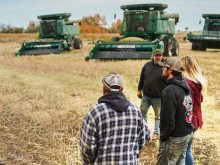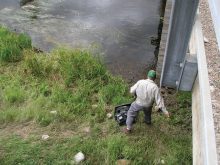I’m not dead, I’m just married!”
These were my words to Grainews editor Leeann when she wondered if I was writing another column anytime soon. That was several weeks ago. Being married and also farming in two different locations has certainly blown my hair back these last several months. The logistical challenges, not to mention the challenges of two people getting used to different styles of farm management have not been minor, although they are not the topic of this column. That might be better suited to a cup of coffee around the kitchen table.
Read Also

Gentle treatments for pain in the neck
Heading toward year-end, people unknowingly tense up against the cold and busyness, causing neck pain that can often be treated with appropriate support and gentle mobility, athletic therapist Kathlyn Hossack says.
However, being part of a new farming community did prompt this column. Having new friends and neighbours has given me reason to both scratch my head and nod appreciatively as I observe how they run their businesses. It’s also given me a chance to explain how we run things on our farm. One area that has prompted questions is that of joint equipment ownership.
We share a picker truck with one neighbour, a heavy harrow with another and our high clearance sprayer with a third. The last item is the one that elicits the most raised eyebrows when I tell fellow farmers in my husband’s community. It’s one thing to share a piece of equipment that doesn’t get called into action during the crunch times, but a sprayer? My dad and our neighbour bought a sprayer together the season before I moved back to the farm, so it’s the only way I’ve farmed and I often take for granted how well the system works for us. Yes, spray windows can be short when skirting prairie cloudbursts and crop and weed conditions that change rapidly, but we’re on our seventh season and second machine. Here’s how we’ve made it work.
Own good equipment
My dad contributed this point to my column. The two sprayers we’ve owned in partnership have not been brand new, but they’ve been reasonably late model, low hour machines. Nobody likes fixing when she should be working and since cranky pieces of equipment don’t break down “fairly,” it’s best to have equipment that is in good condition. Otherwise, it’s easy for one person to feel like he or she is always the one fixing. Of course, the cost of major repairs, should they be needed, are shared.
Pick a like-minded partner
It’s very important to be on the same page in terms of maintenance and care for whatever piece of equipment you share. This spring we traded the Case 4410 sprayer that we shared with our neighbour in on a 4430. Our sprayer partner put a mini corn broom in the cab of the new sprayer and ever since the first acre, I don’t think he’s finished a spray job without sweeping out the cab. I’ve done likewise, motivated at least as much by guilt of leaving the cab worse than I found it than by my own sense of fastidiousness. It might seem like a finicky little thing, but it’s an indication of a bigger philosophy of care for your investment that means oil is checked daily and changed on time; broken parts are replaced as soon as possible; the machine is regularly put in the shed at night.
Keep things in perspective
Both owners farm around 2,500 acres and there’s no reason that a machine with 120 foot booms, a 1,200 gallon tank and the capacity to glide across the field at 12 to 15 miles per hour can’t spray 5,000 acres per season. That said, there are times when I don’t get to use the sprayer the exact hour that I want to and I’m sure my neighbour feels the same way at times.
But, I remind myself that if the cost of the machine wasn’t being spread over 5,000 acres, I certainly couldn’t afford a machine as large and comfortable as the one we have. If I had to spray my farm with a pull-type sprayer or a smaller machine that I had to fill more often, I still wouldn’t be getting to every field as quickly as I wanted.
Communicate, communicate, communicate
This is one piece of advice that applies to joint owners of equipment and newlyweds alike. Every spray season is different. Last year with dry conditions it didn’t really matter if I sprayed today, I could probably spray tomorrow. This year was different. Both my neighbour and I seeded our entire farms in about a two-week span, so our crops were basically all ready to spray at the same time. With adequate moisture and warm conditions, weeds grew quickly and windy days limited the available hours of good spraying conditions. Our spraying schedule was very dynamic this year. My partner and I usually talk at the beginning of the week during herbicide application season and make a rough plan. From there it’s often daily or even more frequent check-ins to decide on the next most important job. Sometimes I would start spraying peas in the morning before it got too warm and then I would clean up and he would spray Liberty on canola and then we’d be back to cereals by evening.
I felt like I did a lot more clean outs this year than last, but there was very little downtime during the two weeks of herbicide spraying and everything got done on time. When it comes to cleaning out, communication is key. What herbicide was used last? Were the tank, booms and nozzles triple-rinsed if moving on to a sensitive crop?
Hauling water is another area where good communication and collaboration result in happy farmers. We usually keep the water trailer parked at a central location and fill from there and while we don’t tender water to the field for each other, one of us can go load up and be back to the filling spot while the other is spraying.
There’s probably a lot more that could be said about sharing equipment, but those are the key points for us. It is possible to share a critical piece of farming equipment as long as both owners have the right mindset.
















